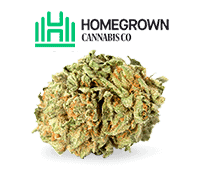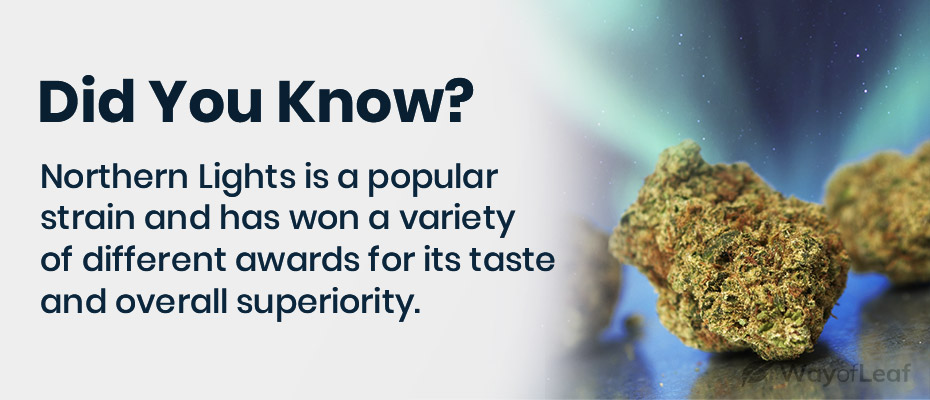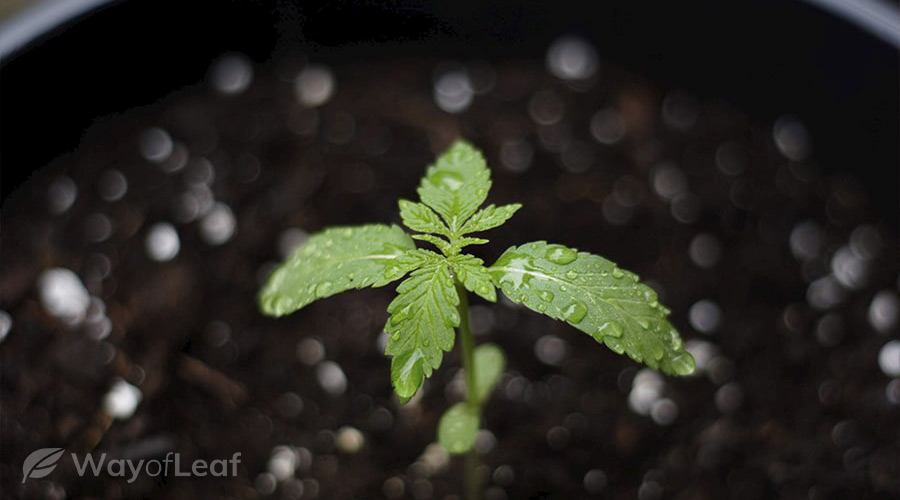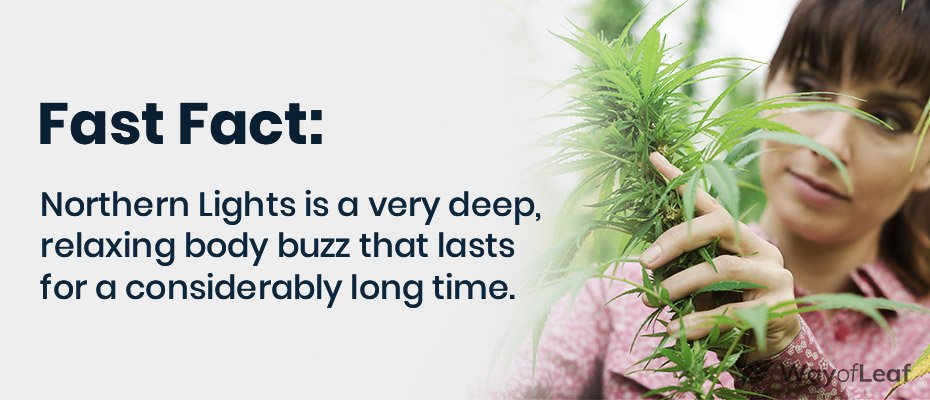Grow Weed Easy Northern Lights Auto Grow
The practical guide
If you have even rudimentary knowledge about marijuana, you will have heard of the Northern Lights strain. This classic indica strain is a cross between an Afghani Indica and a Thai Sativa. It is considered the 'gold standard' of indicas but was bred and crossed since the first day it arrived in the Netherlands. Today, the term 'Northern Lights' is almost generic, as it could apply to one of at least 11 original plants.
Initially, Northern Lights was a pure indica strain or an indica-dominant hybrid that rarely grew over four feet tall. It drew admiration for its deep green color and broad leaves. During its history, breeders mixed the strain with some potent sativa genes. Today, it is a plant marketed as easy to grow and which offers an intense high with a hint of euphoria.
It is the Northern Lights #5 strain that has earned the most significant number of plaudits. It is a multiple High Times Cannabis Cup winner and is recognized as the best NL strain, with #1 a close second. Sensi Seeds in Amsterdam has famously propagated it. With a THC content of 18%, it offers a strong high without being overpowering. In this growing guide for Northern Lights, we offer eight steps and tips to help you get the most potent and flavorful crop.

EDITOR'S CHOICE – Homegrown CannabisCo
Homegrown CannabisCo are the masters when it comes to seeds. Offering a massive variety of cannabis seeds that are well categorized, not only does this company create a resource for superb quality options including feminized seeds, it also provides extensive growing information for those looking for some support along their journey.
Tip #1 – Finding Great Genetics
No matter how carefully you grow your marijuana plants, low-quality genetics will thwart your efforts. Traditionally, Northern Lights is a hard-hitting indica, but it can help create well-known hybrids such as Shiva Skunk and Super Silver Haze. Although you can purchase NL seeds online, it is best if you seek out local gardeners as they can sell you seeds that are acclimated and bred for the climate.

A seasoned grower will create a Northern Lights strain that is resistant to pests and fungus, and will also know how to get the highest potency and yield. Although NL is an indica, try and look for seeds with an indica/sativa hybrid because they have the right traits for indoor growth. Pure indica weed offers a heavy high that makes you very tired while pure sativas are hard to grow indoors. A hybrid is easier to cultivate and provides the cerebral high and energy of a sativa.
Tip #2 – Consider a 'Constant Harvest' Strategy with Indoor and Outdoor Growth
Northern Lights grows well using the Sea of Green (SOG) method, and you can use soil or a hydroponic growing medium. You can also benefit from multiple growth cycles each year if you can use indoors and outdoors to your advantage. Use outdoor light during the flowering process and indoor light for vegetative growth and germination. This process helps utilize the natural light cycle, reduce your energy bill, and enjoy several harvests per year.
In the winter, use your indoor space to begin growing from seedlings or cuttings you took from previously successful Northern Lights plants. By the spring, you can place your plants outside, and natural sunlight begins ripening the marijuana. If you do this correctly, you could benefit from up to three harvests each year! If you have enough space, it is possible to continually begin indoors and flower outdoors with 60-day crops a distinct possibility in some areas.
It is essential to understand that Northern Lights has two growth cycles. Once you germinate the seeds, your NL plants reach the vegetative stage and require vast amounts of light. The strain requires a minimum of 18 hours a day, and ideally, there is no dark cycle at all. Remember, dark periods result in the halting of photosynthesis, which means outdoor growing during the vegetative stage is not ideal.
Once your plants are around 18 inches tall, you can force them to flower outside by planting outdoors during the spring. At this point, expose your Northern Lights plants to 12-hour cycles of consistent darkness for a couple of weeks to enter the flowering stage. After around 6-7 weeks of flowering, your NL plants should be approximately three feet tall and ready for harvest.
For reference, if you move your NL plants outside in early March, they are generally ready for harvest by late April. If you move them out in early May, they will be ripe by the end of June. You can go through this process three times during the year and in winter, move everything indoors and plant a crop for seed to get ready for future growth. Most experienced growers prefer to complete their main harvest in May.
Tip #3 – Put the 'Lights' in Northern Lights
The trouble with growing indoors is the expense associated with lighting. Remember, you need to expose your NL plants to at least 18 hours of light a day during the vegetative stage. Typically, the minimal light exposure is approximately 140 Watts per square foot (for incandescent light bulbs) or 35 Watts using fluorescent LED lights. Ideally, your target is 180 Watts and 45 Watts respectively. You can go even higher if you're planning to increase CO2 levels.
Most indoor growers opt for High-Intensity Discharge (HID) lamps, which are available as High-Pressure Sodium (HPS), Metal Halide (MH), and Mercury Vapor lighting. It is possible to use HPS lamps to grow your Northern Lights crop from start to finish. Although it usually takes over a week longer for an HPS lit crop to mature than if you use MH, a larger yield is often your reward.
Tip #4 – Feeding Your Northern Lights Plants
Northern Lights is typical of most marijuana plants in that it needs high levels of nitrogen (N) during the vegetative stage. It also requires high amounts of phosphorus (P) and potassium (K) during the flowering stage. Unlike most weed strains, however, NL can take higher levels of N throughout its growing cycle because it is less likely to feel nitrogen burn.

If you are a new grower, be wary of overfeeding because it can happen a lot more quickly than you think. The store-bought products that are available are highly concentrated and not suitable for use on young plants. Despite NL's durability, you can still give it root and nutrient burn. Signs that you are overfeeding your plants include leaves and roots with yellow and black discolorations.
The simple rule is 'less is more'! It's true that your NL strain needs a lot of different nutrients. Aside from the 'big three,' your plant requires sulfur, calcium, and magnesium. It also needs trace amounts of copper, boron, iron, manganese, and zinc. Any plant food worth its salt will contain all of the above in the right quantities. These manufacturers want you to use lots of their products so that you buy more. In reality, half of the recommended dosage is enough for starters.
Remember that the majority of potting mixes (soils) on offer are pre-fertilized. As a result, you shouldn't need to add extra nutrients in theory. Potting mixes will have the N-P-K figures displayed on the packaging. If it says 12-16-20, for example, it means the blend contains 12% Nitrogen, 16% Potassium, and 20% Phosphorus.
Tip #5 – Strike the Right pH Balance
Regardless of whether you're using soil or hydroponics, the pH level of your growing medium will make a significant difference to your yields. The optimal pH range for marijuana is between 6.0 and 7.0, although it drops 0.5 or so in hydroponic setups. Some experts go even further and suggest that Northern Lights works best in a pH range of 6.2 – 6.7.
For the uninitiated, the pH of a substance is a measure of its acidity or alkalinity. On the pH Scale, anything below 7.0 is acidic and anything above 7.0 (to 14.0) is alkaline. The decimal points on the scale are crucial because the concentration changes by a factor of ten for every whole point. Therefore, an increase from 6.0 to 7.0 is a tenfold increase! If you are even 0.2 or 0.3 outside the optimal range, the growth of your marijuana will suffer.
The pH of a plant's growing medium dictates the availability of nutrients at the roots of the plants. Like most weed strains, Northern Lights prefers a mildly acidic medium. The pH ranges of nutrients added to the soil varies greatly, which is why adding the right concentrations is crucial. For example, Zinc can have a pH of 5.0 while Nitrogen can have a pH of 7.5.
For the record, the pH of rainwater is 5.5 – 6.0, which should interest outdoor growers. If you use soil as your growing medium, you are less likely to encounter pH difficulties. This is especially the case when using a potting mix that feeds your plants automatically and eliminates the need for any additional nutrients.
Otherwise, it is possible to continue adding nutrients to fix a deficiency and reach the point where your unfortunate NL plants are unable to consume any more. At this stage, the growing medium can experience a buildup of salts which blocks the roots and results in starvation. In other words, overfeeding causes your plant to go hungry!
If your soil is too alkaline, use rainwater to water the plants. On the other hand, if your soil is too acidic, add a tablespoon or two of Dolomite lime per gallon of soil. If you are using a hydroponic setup, make sure the pH remains in the 5.5 – 6.5 range. You should invest in pH strips or a digital meter to check the pH of your growing medium regularly.
Tip #6 – Eliminating Pests & Diseases
These are the biggest issues facing marijuana growers today, and cultivating Northern Lights indoors does not spare you. Prevention is always the best option, which means maintaining a clean growing area and excellent personal hygiene. Although NL is one of the most pest-resistant strains on the market, you can't afford carelessness.
You can stop pests or infections from gaining a foothold by ensuring the humidity and temperature of your grow area are at optimal levels. You must filter the air intake because it blocks a significant path for pests. A high-quality household filter should prevent most insects, hair, and dust from getting in.

Here are a few pests and diseases to watch out for:
- Fungus gnats: Their larvae attack roots, seedlings, and weak plants that invite further infections. You typically find gnats in dark and damp conditions. To remove fungus gnats, you need a solution consisting of Bacillus thuringiensis. If you are growing in a soilless medium or are using soil, drench it with insecticidal soap or neem oil and prevent infestations by reducing humidity.
- Whiteflies: These pests suck the chlorophyll from your plants and are noticeable by the yellow/white spots they produce on top of the leaves. Add pyrethrum every five days or introduce two Encarisa formosas (tiny wasps) per plant.
- Spider mites: These are the most common pest and appear as tiny dots that hide underneath the leaves. You may need a jeweler's loupe or magnifying glass to spot them. A spray consisting of pyrethrum or neem oil works very well on spider mites.
- Gray mold: Also known as Botrytis, gray mold is the most common fungal disease that afflicts marijuana grown indoors. It takes hold around two weeks from harvest and can kill your crop in a week. Prevent this mold from appearing by ensuring your grow room's humidity is below 50% during flowering. If you spot the mold, remove it with sterilized scissors and destroy it.
- Root rot: This happens when your roots don't receive enough oxygen. You can create the problem by using un-aerated water or by overwatering your plants. It halts growth and prevents the plant from transferring nutrients. Rotting roots become a pale brown color initially and start to darken. Prevent it by keeping your growing medium clean and avoid overwatering your Northern Lights plants.
Tip #7 – Manipulate the Northern Lights' Plant Structure
When performed correctly, plant training provides you with taller, wider plants that have numerous, evenly spaced colas. The result is a substantially larger yield. Low-stress training (LST) is an excellent option for new growers because it doesn't involve cutting the plant. The goal is to force your plant to grow full and flat by bending it.
The Sea of Green (SOG) method we mentioned earlier works well with Northern Lights. Another well-known process that increases yields is called 'Supercropping.' It involves bending your plants so that the individual stems lie flat and create a knuckle where you bent them.
One of the most controversial high-stress training (HST) methods involves cutting the plant and is called defoliation. Before we continue, it is important to point out that this should be the sole preserve of expert growers. Although it is effective when performed correctly, defoliation can kill your plants if you get it wrong.
As you can probably guess from the name, defoliation involves removing leaves from your plants. It must only be used in specific situations and is not an effective method of improving outdoor yields. The wrong way to defoliate is to focus on removing slow-growing and 'sickly' leaves. The problem here is that the process only makes weak plants sicker and more susceptible to disease.
Tip #8 – Control Temperature & Humidity
As Northern Lights is known for flourishing in warm, sunny climates, it is best grown outdoors in areas that have long, hot summer seasons. Otherwise, you'll need to grow it indoors and keep it at a temperature of between 70- and 85-degrees Fahrenheit. It is best to err on the side of caution and keep closer to the lower end of that scale during the flowering stage.
The range during the night time (when the lights are off for indoor growers) is ideally no more than 10 degrees lower than the daytime temperature. You will best control heat by placing ducting from your grow light to the window in a straight line to improve airflow.
Heat rises, so make sure you expel it from the top of the grow room to allow cold air to get drawn in from near the ground. If you don't vent hot air through a chimney, window, or another outlet, the grow lights will rapidly increase the temperature in the room.
Northern Lights starts to struggle at temperatures above 85 degrees unless you have added extra CO2 to the room. It is better to expose your NL plants to excessively high temperatures than low ones. While excess heat slows growth, you can rectify the situation relatively quickly. Once your plants are continually exposed to temperatures of 60 degrees or less, they become more susceptible to infestations and can even die overnight!
You also have to ensure that there is the right level of humidity in the grow room. If there is too much, you slow growth. If there isn't enough, your plants become prone to mold and fungus. You should keep humidity above 60% when you are growing seedlings and when the plant is in the vegetative stage.
Once your plant begins to flower, it is time to reduce the humidity by 5% per week. Lower temperatures are also vital at this point because it helps your Northern Lights plant produce potent buds covered in trichomes. There are plenty of all-in-one devices on the market that enable you to monitor humidity and temperature.
If you plan to spend hundreds, if not thousands, of dollars on seeds and marijuana growing equipment, why can't you pay a few extra bucks for a high-quality thermometer and humidity monitoring unit?

EDITOR'S CHOICE – Homegrown CannabisCo
Homegrown CannabisCo are the masters when it comes to seeds. Offering a massive variety of cannabis seeds that are well categorized, not only does this company create a resource for superb quality options including feminized seeds, it also provides extensive growing information for those looking for some support along their journey.
Source: https://wayofleaf.com/cannabis/growing/8-tips-for-growing-northern-lights-cannabis
0 Response to "Grow Weed Easy Northern Lights Auto Grow"
Post a Comment